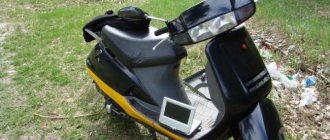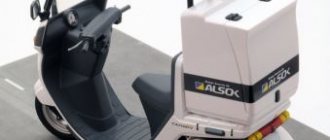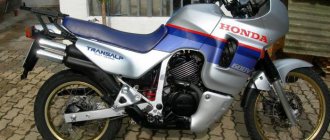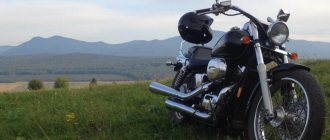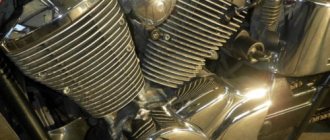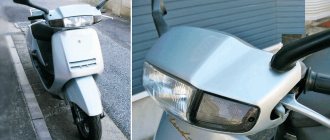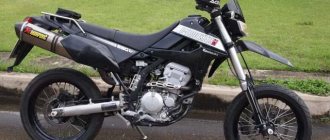Main settings
The model was called “Honda Lead 50” and was a small-sized single-seater vehicle with a miniature two-stroke engine with a power of 5 hp. With. and consuming only 1.3 liters of fuel for every 100 kilometers. The engine volume did not exceed 49 cc/cm, and was air-cooled.
The Honda Lead 50 scooter did not have a gearbox; the transmission was a CVT type. The small car was distinguished by good maneuverability, the minimum turning radius was only 1.7 meters. The fuel tank held 5.3 liters of fuel.
Sales of the Honda Lead 50 have remained consistently high for six years. And when the scooter was modernized in 1984, received a more powerful engine and turned from a single-seater into a double-seater, the demand for it increased by an order of magnitude.
History of the brand
Honda is a company founded in 1946 by Japanese engineer, inventor and racing driver Soichiro Honda, born in 1906. The company, in its current form and with its more than 50-year history, exists because of his daring, inventive and unconventional way of thinking and acting.
Typa-47X Born into a poor family, Honda, without finishing school, already at the age of 16 became an apprentice at an auto repair shop in Tokyo. His early attachment to motor vehicles was due to his father’s profession - a blacksmith who repaired bicycles and instilled in his son the skills to solve technical problems. In 1928, having saved enough money, he returned to his hometown in Hamamatsu Province and opened the first repair shop there. In the same year, he received the first of hundreds of his subsequent patents - for the idea of replacing wooden spokes in a wheel with metal ones. Honda's inventions in the future brought him fame as a person capable of finding simple solutions to complex problems. In 1938 he invented the piston ring; The production of rings was carried out by the Tokai Seiki Heavy Industry company founded by him in 1937.
1988 models
Six years after the start of production, the company released a new Honda Lead scooter with an AF-20E engine. The popularity of this scooter was amazing in its scope. At that time, there were two more 50cc models on the market, the Suzuki Adress and the Yamaha Axis. With the advent of the Honda Lead AF-20E, sales of Yamaha and Suzuki fell sharply. Dealers of the three leading Japanese companies had to share the sales market.
Technical characteristics of the Honda Lead AF-20 scooter:
- cylinder volume - 49 cubic cm;
- engine power - 6.5 liters. With.;
- torque - 0.73 at a speed of 6000 rpm;
- compression - 7.2;
- fuel consumption - 1.72 liters per 100 kilometers at a speed of 40 km/h;
- cooling - air;
- gas tank capacity - 7.2 liters;
- front brakes - disc, ventilated;
- Rear brakes are drum.
Peculiarities
Along with the thoughtful placement of the main components and assemblies, a decent fuel reserve and efficiency, owners note the ability to operate the mokika on various types of road surfaces. The average price of a Japanese serial moped, depending on the model and condition, varies from five hundred to one and a half thousand dollars.
Users note the excellent characteristics of both the version with a 50 cc engine and the ninety cc version. The second modification is faster, but at speeds over eighty kilometers per hour it is not so stable on the road. This is not surprising, because this technique is designed for moderate movement, and not for cross-country racing.
Original spare parts for the Honda Lead 90 scooter can be purchased to order. This is especially true for plastic. It is quite difficult to find a body kit of the required quality on the open market.
Model HF05
The second most popular scooter was the Honda Lead 90, also created in 1988. The two-seater scooter was produced under the HF05 brand.
Weight and dimensional parameters of the model:
- dry weight 78 kg:
- total weight - 85 kg;
- landing height - 735 mm;
- ground clearance, ground clearance - 110 mm;
- center distance - 1235 mm;
- scooter length - 1755 mm;
- height - 1060 mm;
- width - 715 mm;
- Gas tank capacity is 7.2 liters.
Power point:
- cylinder volume - 89 cubic/mm;
- cylinder diameter - 48.0 mm;
- piston stroke - 49.6 mm;
- compression - 6.4;
- maximum power - 8.4 liters. With. at 6500 rpm;
- torque - Nm 1.0 at 4000 rpm;
- fuel consumption - 1.85 liters per 100 km at a speed of 50 km/h.
Appearance
A distinctive feature of the scooter is the shape of the plastic. In the front part it has an almost rectangular shape and is, in fact, a shield. Engineers implemented this idea to improve roominess characteristics, but at the same time aerodynamics suffered.
The Honda Lead AF20 is equipped with a powerful headlight with 2 lamps.
The front optics have a narrow rectangular shape, the turn signals are fused with the headlight on the steering wheel. The scooter base is a steel frame AF20 and durable plastic with metal fasteners. You can attach a basket to the front of the scooter; on the driver’s side there is a fairly large glove compartment, where, in addition to keys and documents, more than one bottle of water can fit.
Honda Lead AF20 is a two-seater scooter.
The profile shows an elongated and wide seat that can easily accommodate 2 people. Its rear end is slightly raised and there is an extended trunk with a handle behind the passenger. The rear optics are presented in the form of a strip and are placed in the lower part of the body, next to the rear wheel.
Honda Lead AF20 1998.
Interesting moment! Due to the specific shape of the plastic, the scooter has a large width, which improves the comfort of the driver and passenger.
Scooter parameters
Honda Lead AF20 has the following parameters: 1755 mm (length), 715 mm (width), 1060 mm (height). The wheelbase is 1235 mm, ground clearance is 110 mm. The dry weight of the scooter is as much as 84 kilograms, the load capacity is up to 200 kg.
Under the seat of the Lead AF20 there is a large glove compartment for hand luggage weighing up to 10 kg.
Next development
In 1998, production of another model of the popular scooter began. It was a two-seater Honda Lead 100 scooter. The new car was distinguished by its streamlined shape and a large headlight in one block with turn signals. The high-quality plastic lining flows smoothly around the wide double seat, giving the impression of solidity and good design.
The headlights include a powerful reflector with two built-in halogen lamps, creating a dual sharp beam of light that covers a sixty-degree wide area in front of the scooter. The taillights are not so powerful, their design corresponds to low-speed scooters, when powerful brake light and turn signal lamps do not make sense; 10-15 watt bulbs are enough.
Technical characteristics of the “hundredth” scooter
Honda Lead 100 engine, two-stroke, single-cylinder:
- cylinder volume - 101 cubic cm;
- cylinder diameter - 51 mm;
- piston stroke - 49.6 mm;
- cooling - air;
- compression - 6.5;
- maximum power - 9.3 liters. With. at 6750 rpm;
- torque - 1.0 Nm at a speed of 6000 rpm;
- fuel consumption - 2.32 liters per 100 kilometers at a speed of 60 km/h;
- Gas tank capacity is 7.5 liters.
Dimensions and weight parameters:
- scooter length - 1795 mm;
- height - 1060 mm;
- width - 680 mm;
- center distance - 1255 mm;
- ground clearance, ground clearance - 115 mm;
- rider seat height - 660 mm;
- turning radius, minimum - 2 meters;
- dry weight - 92 kg;
- total weight - 99 kg.
Comfort and dynamics
Riding the Honda Lead is a pleasure, the scooter ride is smooth, and the complete absence of vibration is impressive. The scooter was clearly designed for lovers of calm and measured movement at low speeds on a good road. Ideal for beginners who have no experience riding sports bikes and who prefer to stay away from extreme sports. Comfort is undoubtedly present when using the scooter. However, the dynamics of the car are kept at a fairly modest level; the Honda Lead cannot be accelerated so suddenly and immediately. The speed has to be increased gradually. Then the scooter is obedient and responds to the slightest movement of the throttle. If you add gas suddenly, the engine will stall.
Running parameters
The undoubted advantage of the scooter is its chassis, rationally designed brakes and suspension. The front brake is a ventilated disc brake, very effective. The rear drum, which works softly, never jams, turns on with a slight delay relative to the front one, and thus the scooter stops in a split second, without skidding or skidding.
The scooter is equipped with a brake system that never fails. The front suspension is a powerful fork of a lever design, combined with a hydraulic shock absorber. Does not cause any complaints, but requires attention when entering a sharp turn. If the speed is higher than optimal, the suspension arm begins to vibrate and the scooter may lose control. Therefore, when driving on a winding road, you must maintain a minimum speed.
Some models produced in 1999 were equipped with telescopic front suspensions, but they did not take root because they had to operate within a limited amplitude and high loads often caused the unit to break. In addition, such a suspension was more rigid, unlike a lever one, and “caught” all the irregularities, causing shaking.
Honda Lead 100 scooter review
The fairly strong demand for this model is partly explained by the great popularity of its predecessor, the Lead 90 , which is the most renowned scooter with an engine capacity of more than 50 cm3 on the used market.
There is nothing in common between the modification 90 and the current SCV 100, besides the name and philosophy. This is a scooter that is simple in design and easy to maintain and service. At the same time, the 100 cc engine gives no reason to doubt its practicality and convenience for urban use, especially since the chassis, with its geometric dimensions, “fits” it into the “fifty-kopeck” group. Obviously an absolutely economical approach from a familiar manufacturer, combining an unpresentable chassis and a good engine.
Modern design in the best traditions of the Japanese school: not screaming, but cold-blooded, but with one colorful facet, which this time is the beautiful arrow-shaped turn signals crossing the front fairing. Otherwise, there are practically no outpourings or frills, everything is familiar.
However, there is an excuse to jump into the saddle immediately, without stopping at the particulars. Sitting on the spacious seat is comfortable and does not cause any complaints, although for women of short stature it may even be a little too wide. There is a small “step” on it, although its purpose is not to restrain during violent accelerations, but to symbolically separate the territory of the driver from the passenger. By the way, it will be noted that the passenger also feels completely decent, but the footrests are somewhat merciless to the feet, because they need to be “folded” slightly inward, which is quite exhausting for long-term travel. Meanwhile, behind the driver’s back, the rider feels like behind a stone wall: the wind does not bother you at all. The driver has the usual amenities, in the form of free space between the steering column and the seat.
For a potential client, it is much more important to understand that the power unit of this scooter, unlike its ancestor, switched to 4 strokes, and its volume increased to 102 cm3. Discussing this metamorphosis is undoubtedly difficult. On the one hand, the power unit has lost its strength, and acceleration does not have the same liveliness. On the other hand, traction in the mid-speed region has clearly become more confident, so that a scooter with 2 men of 70 kg each on board, going uphill, easily and arbitrarily maintains its cruising speed of 60-65 km/h. If you drive alone, then it is quite possible to achieve 80-85 km/h, although this is certainly not enough for a 100cc scooter. But let’s not forget that we are talking about a unit that is undoubtedly intended for inexperienced drivers. According to the Japanese stereotype, the low beam shines continuously - this is a positive moment in safety.
The controllability of the scooter does not bring a repulsive feeling; it is agile and completely stable in a straight line, although the front has a conventional and rather soft lever suspension. At the rear, the suspension in the unit with the engine and variator is responsible for everything, and due to such weight distribution, the heavy 100cc engine clearly relieves the load on the front wheel during acceleration.
A colorful example of the budget approach to creating a scooter are the drum brakes at the front and rear. While the tire is not warmed up, reckless and careless handling of the front brake can lead to wheel locking and an unpleasant situation on the road. However, if you don’t strain yourself (press with two fingers and let the rubber heat up), then braking will be absolutely consistent with the potential of the engine and chassis.
In general, the scooter left a rather nice impression with its flexibility and unambiguity, and the bonus was a fairly good cargo compartment under the saddle, accommodating a scooter helmet, and a hook for attaching bags, determined on the basis of the seat.
Delivery of scooters and other goods from Japan to Moscow can be carried out by Alberani Logistics - reliable delivery of any goods to Russia.
Leadership
The Honda Lead scooter in the entire history of production was considered the most successful model among its kind. The model is still a leader today, thanks to its exceptional technical characteristics.
Initially, the scooter was created for intensive use, so high-strength parts were immediately included in the design. Therefore, the car turned out to be super reliable, with a long service life and wear resistance. The performance characteristics of the scooter provide a high degree of cross-country ability, which is sometimes of great importance. At the same time, the engine does not suffer from dust, dirt and other external factors, since clean air enters the carburetor from under the seat. The scooter is quite suitable for use on country roads. In winter, the car can overcome snow cover up to twenty centimeters thick.
From the first days of production of the scooter, I was concerned with high-quality and varied painting. Initially, the classic white and black colors in various combinations were taken as the basis, and then they began to use a range of twelve colors. Various combinations of bright colors significantly increased the attractiveness of small two-wheeled cars and this had a positive effect on sales.
User impressions
Owners of Japanese-made scooters highlight a number of advantages and disadvantages of a moped. Among the advantages, the following aspects are noted:
- high quality casing plastic;
- excellent running parameters;
- ease of landing;
- high engine life;
- beautiful design and ergonomics;
- good speed and dynamics;
- stability on the road with any surface;
- elaborate suspension unit.
Among the disadvantages of the Japanese mini-motorcycle, users highlight an unreliable oil pump, possible overheating of the piston group and rather weak maneuverability. In general, the Honda Lead 90 scooter is an excellent vehicle for driving around the city and traveling short distances on country roads.
How to choose a model
The most popular modifications from the Lead Honda line are the “50 cc” and “90 cc” versions. Both scooters are assembled in identical housings, but the engine power differs significantly. The engine thrust is what you need to focus on first. Some buyers will be satisfied with the engine power of 5 liters. With. (50 cc), most scooters are equipped with these. Owners who are used to driving together are better off purchasing the HF05 model with an 8 hp engine. s., which according to all data exceeds 50 cc.
Modifications
The second generation of Japanese scooters "Honda Lead 90" is represented by several variations, ranging from a model with a fifty-cc engine to a more powerful modification, the engine power of which is almost twice as strong. Let's briefly consider each of the options.
- Model AF 20. This mokik is distinguished by a small volume of the power unit, which is 49.9 cubic meters. cm. Otherwise, according to the owners, the scooter is stable on the road, perfectly balanced, most vibrations are absorbed by the front fork with levers thanks to a well-thought-out design. The aggressiveness of the moped is given by a voluminous body kit, which also performs the function of protecting riders from dirt and dust. The front light element is equipped with a pair of powerful lamps, providing good visibility at night. The front fender provides additional protection.
- "Honda Lead SS". One of the first representatives of the family in question. Judging by the reviews, the moped is practical, reliable, has an excellent seating position for the driver and passenger, and has good driving performance.
- Modification 110 is a scooter for young people. The owners note that the unit has an appropriate body kit, is equipped with a spacious trunk, an injector and a liquid cooling system.
However, the most popular option in this series, judging by the reviews, is the Honda Lead 90 moped, the characteristics of which are presented above.


